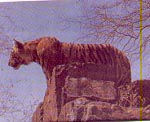|
|
|
Ranthambore National Park
|
 Situated in Eastern Rajasthan, where the Aravali Hill ranges and the Vindhyan plateau
meet, the Ranthambhore National Park is bound by the rivers Cahambal in the South
and Banas in the North. The Park which is 392 square k.m. derives it’s name from
the Ranthambhore Fort which sits on a rocky outcrop in the heart of the Park. The
fort, which dates back to the 10th century and is probably the oldest existing fort
in Rajasthan, was a vital citadel for control of Central India and particularly
the Malwa plateau.
Situated in Eastern Rajasthan, where the Aravali Hill ranges and the Vindhyan plateau
meet, the Ranthambhore National Park is bound by the rivers Cahambal in the South
and Banas in the North. The Park which is 392 square k.m. derives it’s name from
the Ranthambhore Fort which sits on a rocky outcrop in the heart of the Park. The
fort, which dates back to the 10th century and is probably the oldest existing fort
in Rajasthan, was a vital citadel for control of Central India and particularly
the Malwa plateau.
These forests were for long a private hunting grounds of the Jaipur royal family
and the big cats were virtually hunted to extinction before the Project Tiger took
over the management of the forests in 1973. In 1981, Ranthambhore was awarded the
National Park status. The Man Singh sanctuary, the Kaila Devi sanctuary and the
Kuwalji game reserve are three other large tracts of forests which are contigous
with the Park.
Characterised by rocky plains with gentle slopes, flat hill tops and precipitous
cliffs covered by a dry decidous forest, the landscape is dotted with old banyan
trees, dhok trees, flame of the forest, mango and few areas of evergreen black berry
trees. Six man made lakes are the central focus of the park and many perennial streams
criss cross the entire park. These streams are totally dry for most parts of the
year but become raging torrents during the monsoon seasons. The Park has internal
drainage and has no link up with any river system, even though two rivers bound
the Park in it’s north and south side.
Ranthambor is famous for its tigers and is a favorite with photographers. The landscape
is dotted with ancient banyan trees, dhok & pipal trees, clusters of mango trees
and crisscrossed with evergreen belts. The terrain is made up of massive rock formations,
steep scarps, perennial lakes and streams and forest suddenly opening up into large
areas of savannah. For a relatively small area, the park has a rich diversity of
fauna and flora - species list includes 300 trees, 50 aquatic plants, 272 birds,
12 reptiles (including the marsh crocodile) & amphibians and 30 mammals.
Other than the tiger, other predators found in Ranthambor are leopard, striped hyena,
jackal, caracal and jungle cat. Also seen are sloth bear, sambar deer, chital (spotted)
deer, nilgai (blue bull) antelope, wild boar, chinkara (Indian) gazelle, Indian
hare, mongoose, common langur, palm civet, palm squirrel, porcupine and monitor
lizard.
For the wildlife savvy, Ranthambore today offers an intense diversity of flora and
fauna. Tigers, the park's pride make it one of the best places in the country to
observe them. Apart from that a large numbers of sambar, chital, nilgai, gazzelle,
boars, mongoose, Indian hare, monitor lizards and a large number of birds.
Area: 392 sqkm
Best time to visit: October - June
How to get there: The nearest town from Ranthambore
is Sawai Madhopur which is also the nearest railhead (about eleven kilometres).The
nearesrt airport is located at Jaipur the capital city of the state of Rajasthan
which is 145 kilometres from Ranthambore.
Accomodation: Excellent hotels at Sawai Madhopur including
Maharaja Lodge (Taj Group), Castle Jhoomar Baori and Hotel Vinayak of the R.T.D.C,
Tiger Moon Resort, The Ranthambhore Bagh, Ankur Resort, Hotel Aurag, Tiger Safari
resort, Ranthambhore Regency and Tiger Den resort.
Prominent Fauna: Tiger, nilgai, boar, sambar, chital,
hyena, gazzell, chinkara, Indian hare, mongoose, leopard, jungle cats, sloth bear,
marsh crocodile, jacanas, painted stork,black stork, peafowl, crested serpent eagle
etc.
For Additional Information:
Field Director
Ranthambore National Park
Sawai Madhopur
Rajasthan
India
|
|